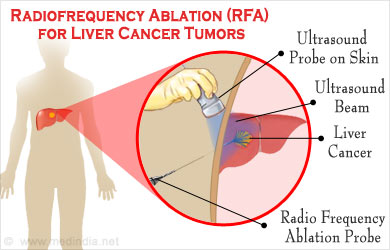Radiofrequency ablation (RFA) is a treatment that uses imaging guidance to place a needle electrode through the skin into a tumor. High-frequency electrical currents are passed through the electrode, creating heat that destroys the cancer cells.
“RFA is an effective treatment option for patients who might have difficulty with surgery and those whose tumors are less than one and a half inches in diameter.RFA can be used for tumors in lung, liver or peripheral organs, etc.” says Dr. Yadav Munde, Interventional Radiologist, Ruby Hall Clinic.
RFA is an alternative to open surgery, interventional radiology procedures may reduce risk, pain, and recovery time for patients.

Radiofrequency ablation (RFA) and microwave ablation (MWA) are treatments that use image guidance to place a needle through the skin into a liver tumor. In RFA, high-frequency electrical currents are passed through an electrode in the needle, creating a small region of heat. In MWA, microwaves are created from the needle to create a small region of heat. The heat destroys the liver cancer cells. RFA and MWA are effective treatment options for patients who might have difficulty with surgery or those whose tumors are less than one and a half inches in diameter. The success rate for completely eliminating small liver tumors is greater than 85 percent.
RFA may be performed to treat tumors in the lung, liver, kidney, and bone, as well as other body organs less commonly. Once the diagnosis of the tumor is confirmed, a needle-like RFA probe is placed inside the tumor. The radiofrequency waves passing through the probe increase the temperature within tumor tissue and results in the destruction of the tumor. RFA can be used with small tumors, whether these arose within the organ (primary tumors) or spread to the organ (metastases). The suitability of RFA for a particular tumor depends on multiple factors.
RFA can usually be administered as an outpatient procedure, though may at times require a brief hospital stay. RFA may be combined with locally delivered chemotherapy to treat hepatocellular carcinoma (primary liver cancer). A method currently in phase III trials uses the low-level heat (hyperthermia) created by the RFA probe to trigger the release of concentrated chemotherapeutic drugs from heat-sensitive liposomes in the margins around the ablated tissue as a treatment for Hepatocellular carcinoma (HCC). Radiofrequency ablation is also used in pancreatic cancer and bile duct cancer.
